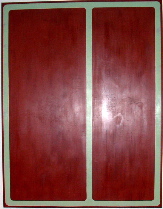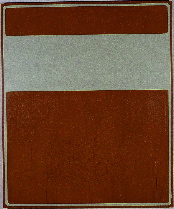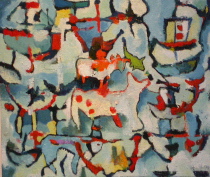
While Libby was at Locks, I made it to 2nd St. where more folks than I expected were looking at art and enjoying the wine and cookies.
Barry Goldberg’s eight encaustic paintings at Larry Becker Gallery seemed a modest crew. In fact, they sit back like wallflowers, a thought that snuck up on me as I realized all the track lighting was pointed straight down at the floor and not at the walls or on the work.
Heidi Nivling, who, with husband Larry, always hangs an elegant show, said they wanted to calm the space, and actually the ambient lighting — cool and unobtrusive — worked very well, turning the paintings into real world objects and not just paintings on the wall. Goldberg’s always been a great color man. His surface-y, encaustic paintings, dense with pigment and smooth, skin-like surfaces, are abstract works whose colors evoke the world and whose subject — to me at least — is the stable relationships between objects (people included) that share some similarities and basically get along. 
I talked with Goldberg who gave me an exclusive tour spilling all the beans behind the work — all the while saying, half-jokingly, “I can’t believe I’m telling you all this,” like the information was some kind of hush, hush, secret stuff. It was funny but it also said much about the back story of abstract art and the titling of it and how sometimes the key to understanding and thus enjoying lies in the verbal-visual interplay. Hmmm, there’s a thought.
So, Goldberg said he had been looking at the night sky alot and that Mars and other celestial bodies were the references. (image, “Phobos and Deimos”, top left, sorry about the flash, and “Asaph Hall,” right)The rich, brick-red color (you gotta see it in person, folks, these pictures don’t do it justice) refers to the red planet and the Celadon green is like the planet’s two moons, Phobos and Deimos, named by astronomer, Asaph Hall. Goldberg’s knock-out Celadon appears in two more works, set off by rectangular outlines of creamy, lemondrop yellow. Yum. “Yanaihara” the smaller and thinner of the two is a kind of homage to Giacometti. And “Stonecrop and Saxifrage,” the larger piece, refers to the plants that butterflies eat. Eat, I asked? Well, whatever. They’re butterfly plants.
In the back room, Goldberg was dealing with the cosmos of dying suns and black and white dwarfs.
You can find human stories in the work. I kept thinking of people, side-by-side in bed, dreaming in color and co-existing in some happy twilight time.
Muse and the paintbrush

Meanwhile, across the street at Muse Gallery Linda Fanning-Lefevre welcomed a smaller crowd into her solo show. The Harrisburg artist, who said she joined Muse a year ago in order to get closer to a metropolitan area, had work that seemed rooted in the Chagallian past. Fanning-Lefevre said she didn’t look at the old masters alot but there was clearly something of Chagall’s spirit that had seeped in to the work. (image, above)
And at Third St. Gallery the small works holiday show was hopping. This large coop gallery, whose members range from representational painters to abstract sculptors and painters, had lots of work on the walls and a few things sold.  I was very happy to see a Tony Rocco photograph in the mix. (image, right. Click the link for more.) What a great (head-less) urban image! I hope Kate Ware (who put together the upcoming “Faceless Figures” exhibit at the PMA (see post of Dec. 2, below) gets around to see it. I’ve seen Rocco’s work before and the young photographer has a way with portraits, too. He’s an up-and-comer.
I was very happy to see a Tony Rocco photograph in the mix. (image, right. Click the link for more.) What a great (head-less) urban image! I hope Kate Ware (who put together the upcoming “Faceless Figures” exhibit at the PMA (see post of Dec. 2, below) gets around to see it. I’ve seen Rocco’s work before and the young photographer has a way with portraits, too. He’s an up-and-comer.

Finally, I present the Artist’s Equity paint brush, a freebie I picked up from from the table set up at Third St. by the AE Philadelphia/Tri State chapter (or as they call themselves P3AE). The membership organization was recruiting. Here’s what they provide for a $30 membership fee: members exhibits, lectures, a newsletter, an artist-run “Health hazards Hotline” and a website.









